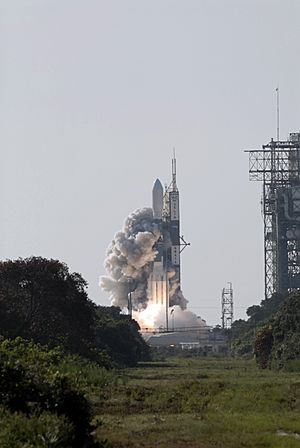Cape Canaveral Air Force Station facts for kids
Quick facts for kids Cape Canaveral Air Force Station |
|
|---|---|
| Part of Patrick Air Force Base | |
| Cape Canaveral, Florida, United States Near Cocoa Beach in United States |
|
| Type | Air Force Base |
| Area | 1,325 acres (5 km2) |
| Site information | |
| Owner | U.S. Department of Defense |
| Operator | Air Force Space Command |
| Controlled by | 45th Space Wing |
| Site history | |
| In use | 1948—present |
| Events | Space Race |
Cape Canaveral Air Force Station (often called CCAFS) is a special place in Florida, USA. It's where many important rockets and spacecraft have launched into space! It was known as Cape Kennedy Air Force Station for a while, from 1963 to 1973.
This station is part of the United States Air Force Space Command. It works closely with Patrick Air Force Base nearby. CCAFS is located on Cape Canaveral in Brevard County, Florida. It's the main launch site for America's space missions from the East Coast.
Today, it has three active launch pads. These are like giant platforms where rockets stand before they blast off. The station is very close to NASA's Kennedy Space Center. Bridges and roads connect these two famous space sites. CCAFS also has a long runway, perfect for large planes bringing heavy equipment for rockets.
Many amazing "firsts" in space exploration happened here. For example, the first U.S. satellite to orbit Earth launched from here in 1958. The first American astronaut in space also took off from Cape Canaveral in 1961. Later, the first U.S. astronaut to orbit Earth launched from here in 1962.
It was also the starting point for the first U.S. two-person spacecraft in 1965. The first unmanned U.S. landing on the Moon happened thanks to a launch from here in 1966. And the first three-person U.S. spacecraft launched in 1968.
Rockets from CCAFS have sent probes to fly past every planet in our Solar System. The first spacecraft to orbit Mars (1971) and explore its surface (1996) began their journeys here. The first American spacecraft to orbit and land on Venus (1978) also launched from this site.
Even missions to distant planets like Saturn (2004) and Mercury (2011) started at Cape Canaveral. And incredibly, the first spacecraft to leave our Solar System, Voyager 1, launched from here in 1977!
Contents
The area around Cape Canaveral has been used for testing rockets since 1949. President Harry S. Truman decided it was a great spot for this. The location is perfect because rockets can launch over the Atlantic Ocean. Also, it's close to the equator, which gives rockets an extra push from Earth's spin!
Key Space Missions from CCAFS
Many important space missions have launched from Cape Canaveral Air Force Station. Here are some of the most famous ones:
- Explorer 1: This was the first U.S. satellite to orbit Earth in 1958. It was a huge step for America in the Space Race.
- MR-3: In 1961, this mission carried the first U.S. astronaut, Alan Shepard, into space. It was a short but historic flight.
- Mercury-Atlas 6: In 1962, John Glenn became the first U.S. astronaut to orbit Earth on this mission. It was a major achievement!
- Gemini 3: This mission in 1965 was the first time two U.S. astronauts flew together in a spacecraft.
- Surveyor 1: In 1966, this spacecraft made the first successful unmanned U.S. landing on the Moon. It helped prepare for human landings.
- Apollo 7: This 1968 mission was the first to carry three U.S. astronauts. It was a crucial test for the Apollo program that later landed humans on the Moon.
- Mariner 9: Launched in 1971, this was the first spacecraft to successfully orbit Mars. It sent back amazing pictures of the Red Planet.
- Mars Pathfinder: In 1996, this mission sent a rover to explore the surface of Mars. It was the first time a rover explored Mars.
- Pioneer program: In 1978, the Pioneer Venus missions were the first American spacecraft to orbit and land on Venus.
- Cassini–Huygens: This spacecraft, launched in 1997, became the first to orbit Saturn in 2004. It studied Saturn and its moons for many years.
- MESSENGER: Launched in 2004, MESSENGER was the first spacecraft to orbit Mercury in 2011. It gave us a close look at the closest planet to the Sun.
Images for kids
See also
 In Spanish: Estación de la Fuerza Espacial de Cabo Cañaveral para niños
In Spanish: Estación de la Fuerza Espacial de Cabo Cañaveral para niños








